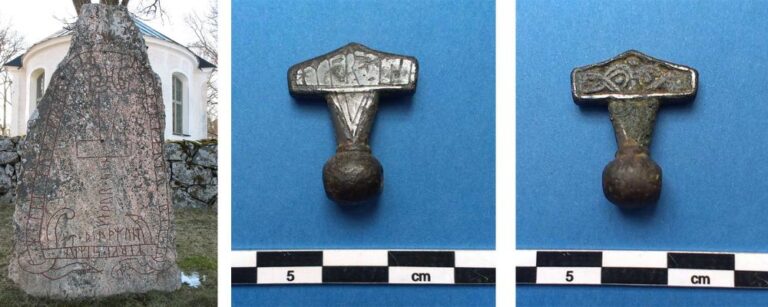When you look around the internet, it is not hard to find examples of Thor’s hammer, or Mjolnir, amulets. They were popular pieces worn in the Viking age, and they are also popular pieces of jewelry among modern-day Vikings and followers of the Norse religion.
When looking at pictures, it can be difficult to determine which are genuine artifacts and which are modern pieces, and which of the many modern Mjolnir pendants available are faithful replicas of ancient pieces.
In this article, we will talk briefly about how Thor’s amulets were worn in the Viking world and then look at some of the finest and most important Mjolnir amulets that have been discovered by archaeologists.
If you want to know more about the mythology behind Mjolnir and read about its creation story, read our earlier post.

How Do We Know They Are Mjolnir Pendants?
More than 150 examples of T-shaped pendants survive from the Viking age, found across Scandinavia, Iceland, England, the Baltics, and Russia. These have been classified as Thor’s hammer amulets. How do we know that is what they represent?
Well, several runestones from across the Viking world represent Thor’s hammer using this same shape and identify the image in the inscription. For example, a runestone from Stenkvista in Sweden shows the hammer as part of a dedication by three sons to their father, who was named for the god Thor.
In addition, in 2014, a metal detectorist in Denmark found a silver Thor’s hammer amulet that carried the inscription “Hmaar x is”, which literally means “this is a hammer”. On this basis, the hundred or so surviving examples from the Viking age have all been classified as representing Mjolnir.
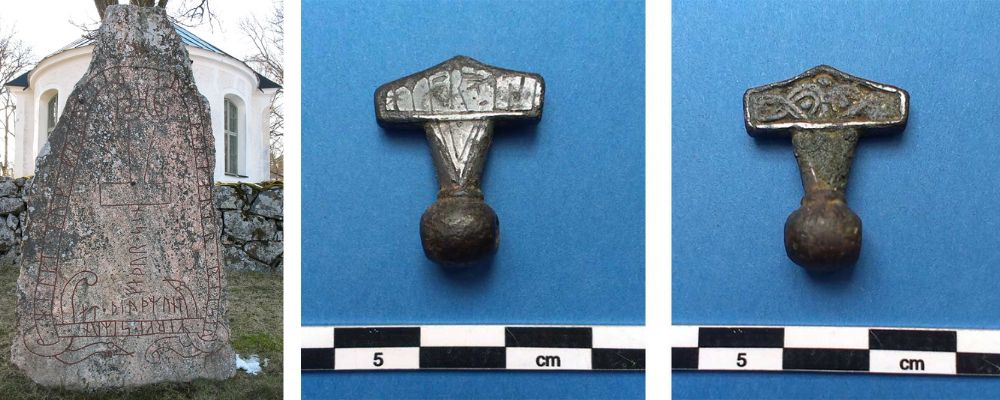
Thor’s Hammer Pendants in the Viking Age Context
The surviving examples are made in a variety of materials, though iron is most common, followed by silver. But there are also examples made from lead, gold, and amber. Similar pendants were probably made in wood or clay for more humble individuals, but these are unlikely to have survived the test of time.
While there are some examples of elaborately decorated hammer pendants, most were plain. This includes examples that were found in elaborate ship burials, suggesting that plain hammers were the standard.
However, Mjolnir pendants should not be considered grave goods, as only about 15% of surviving examples were found in graves. They seem rather to have been symbols of protection and religious devotion worn in life. While some people were buried with their pendants, others may have been passed on to family members.
When you see photos of these pendants, you will usually see them with the handle of the hammer on top. This is because many examples have a punch mark in the handle, suggesting that they were threaded and worn hanging as a pendant. While most would probably have been worn around the neck, a few surviving examples show that they were sometimes threaded on an iron ring with other amulets and that this was then hung from the belt, as a kind of Viking age “charm bracelet”.
While the designs of the hammers suggest that they were often worn, this does not seem to have been their only function. 25 Thor’s hammer amulets were found at the cult center at Tisso in Denmark. They were deposited in the 9th and 10th centuries alongside figurines of Thor and Odin. In this context, they appear to be votive offerings.
Mjolnir pendants continued to be used well into the Christian period and were often mixed up with images of the cross. There are examples of hammers with crosses inscribed into them, combining the two iconographies. This reinforces the idea that the Vikings wore the pendants for protection and as a sign of devotion. This matches the purpose of the Christian cross and explains why the two became closely linked.
Examples of Thor’s Hammer Pendants from the Viking Age
Below are some of the most spectacular examples of Thor’s hammer amulets that survive from the Viking age. They inspire many modern-day replicas.
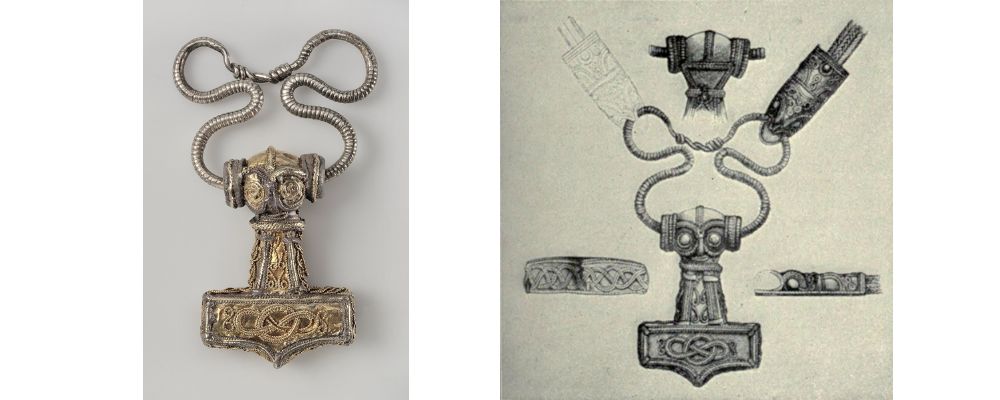
Odeshog, Sweden
The 10th-century Odeshog Mjolnir is probably the most famous because of its incredibly detailed design. Made from silver with gold inlay details, the handle looks like a warrior in a helmet or the face of a raven. This is actually a relatively common design feature, as will be seen. It is thought to reference Odin, the god of war, whose familiars were ravens. The rest of the hammer is decorated with Viking-style knotwork.
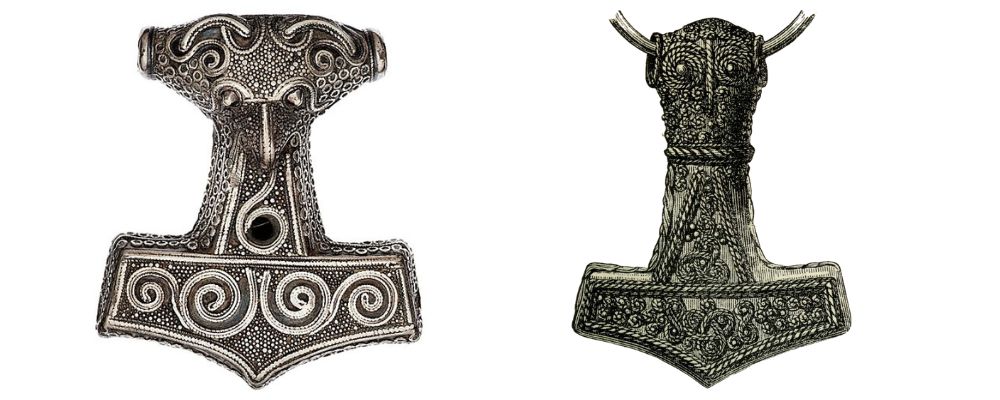
Scania, Sweden
This silver-gilded Mjolnir was found in Scania in Sweden and uses many of the same design elements as the Odeshog example. The handle looks like a raven wearing a warrior’s helmet and the rest of the hammer is decorated with swirls and knotwork. Some researchers have suggested that the swirls and knots are meant to represent the roots and branches of the world tree, Yggdrasil.
Bredsattra, Sweden
This is yet another pendant that follows the same design style, with the warrior-raven head on the handle and knotwork used to decorate the hammerhead. It is gold-plated silver and probably also dates from the 10th century.
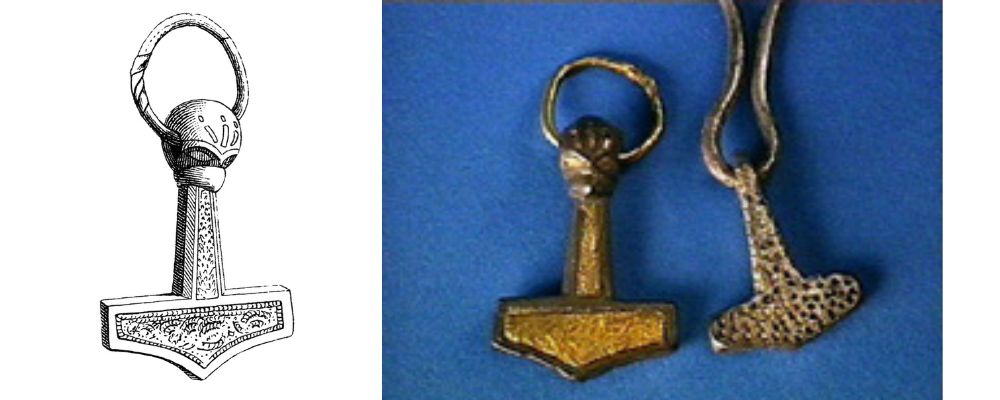
Mandermark, Denmark
These two amulets were found at Mandemark in Denmark, together in a hoard. One is decorated with gold foil and has the same raven-warrior handle. It looks like it is holding the hammer in its mouth and seems to have the same swirl designs. The other has a distinctive dot design that is seen on several surviving pendants.
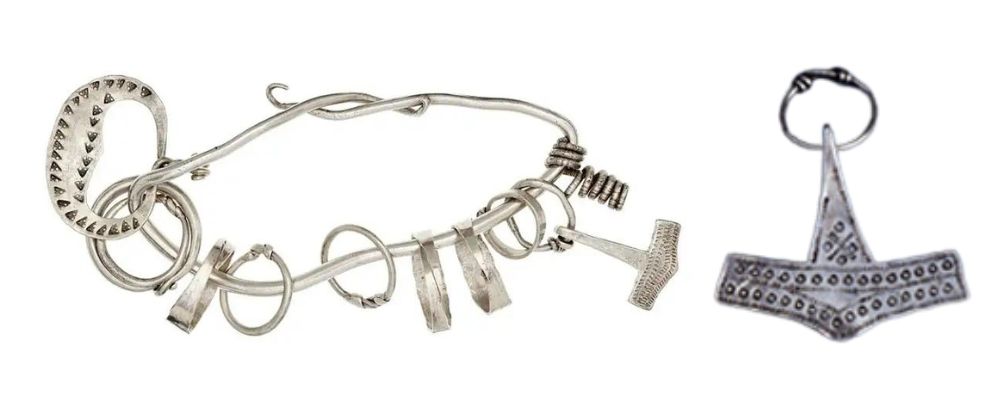
Rømersdal, Bornholm, Denmark
This pendant is a popular piece among replicas because it is well-preserved and has the distinctive dot design. The silver pendant is also historically important because it was found on an amulet ring, confirming the Viking practice of stringing several amulets on a ring and then wearing them on a belt.
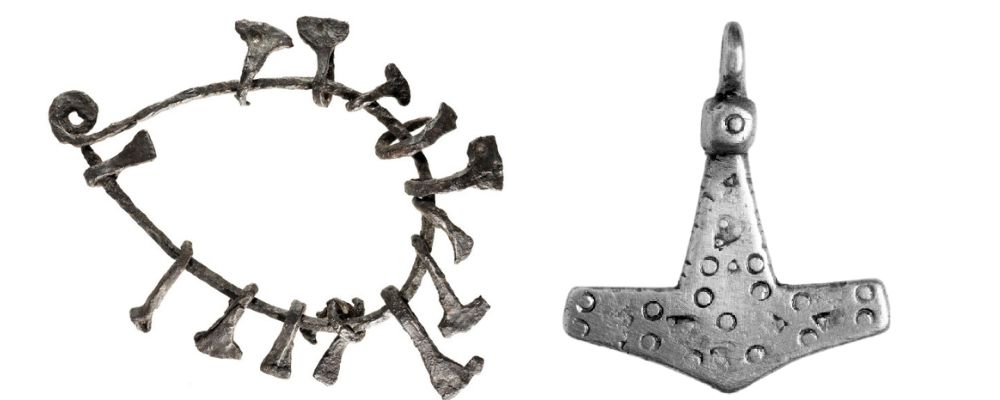
Birka, Sweden
This group of rough iron hammers from Birka in Sweden, dating to the 10th or 11th century, are another example of how Mjolnir’s could be worn as a kind of charm chain. They also show how roughly hewn some examples of the surviving hammers are. It is possible that this group was carried by a seller.
Verdal, Denmark
This Thor’s Hammer pendant from Verdal in Denmark uses a similar dot design to the example from Bornholm and is also made in silver.
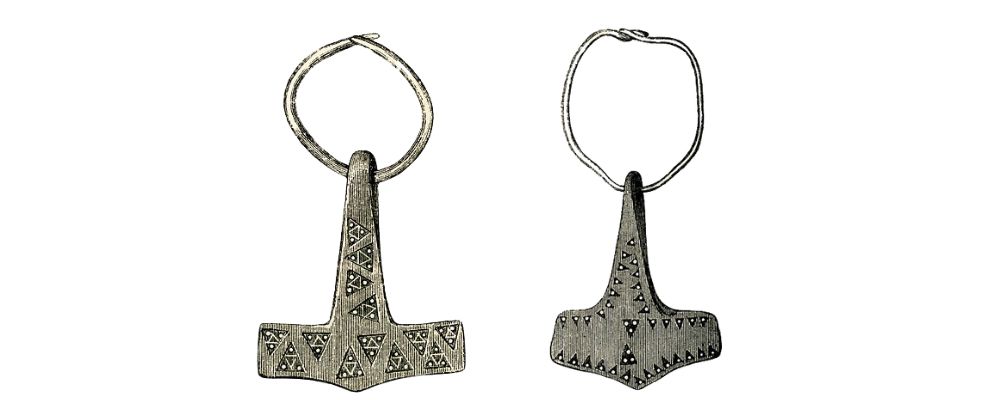
Marheda and Garsnas, Sweden
There are also a few surviving Mjolnir examples that use a triangle and dot pattern, such as these examples from Sweden, from Marheda and Garsnas respectively. It seems possible that these could be simplified versions of the Valknut symbol.
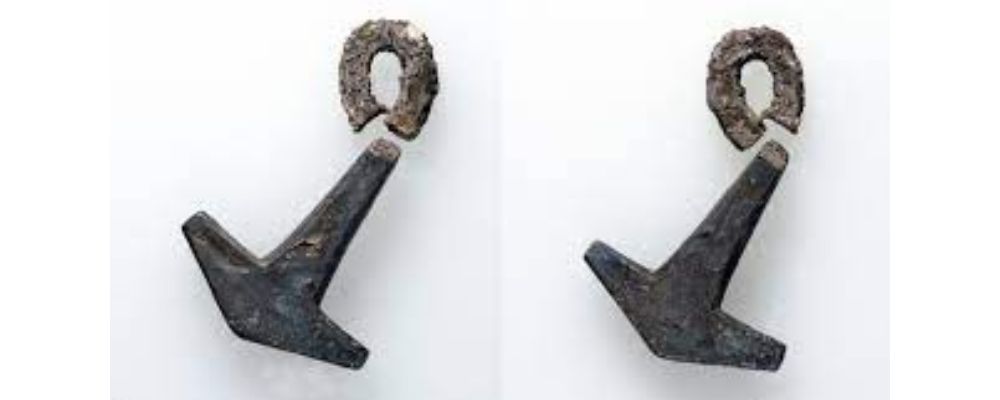
Repton, England
This Thor’s Hammer seems to have belonged to a Viking who died in the 9th century while raiding in England. He was also buried with a sword, a horn, and two beads. The hammer is of plain design but is made in fine silver. The hook at the end of the handle would have allowed it to be worn as a pendant, and it was found near the man’s neck bones.
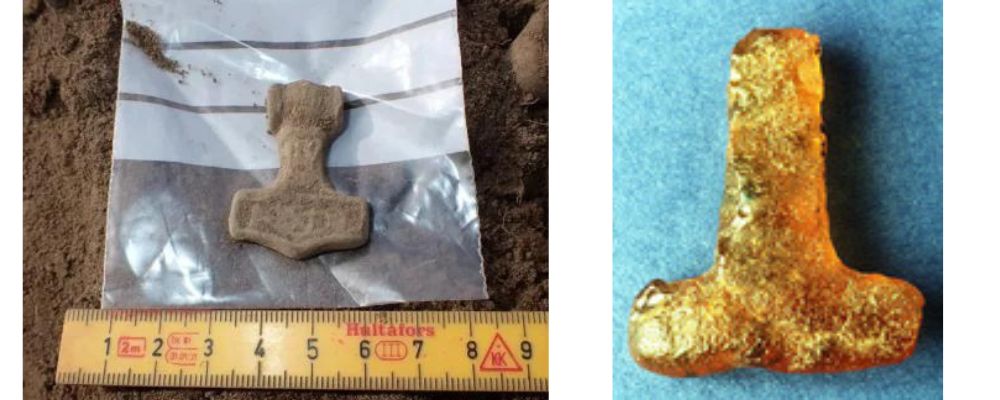
Halland, Sweden
This Mjolnir pendant stands out mostly because it is one of the most recent finds, discovered in 2022. Unfortunately, it was not discovered alongside other materials, so it is impossible to date specifically, but it is thought to belong to the 10th century. It is small, measuring just one inch, so it fits nicely in the palm of the hand and has a hole to be strung. It is made from lead and has a plain design but may have been overlaid in gold or silver.
Wolin, Poland
This amber hammer pendant was found in Wolin in Poland, in a context suggesting that it had a Viking origin and was either worn by a local Viking or secured through trade. It is notable because it is one of the few surviving amber examples. Amber was associated with the goddess Freyja. It was said that when her tears touched the earth, they created gold, and when they touched water, they created amber. It may be that the pendant was meant to honor both Thor and Freyja.
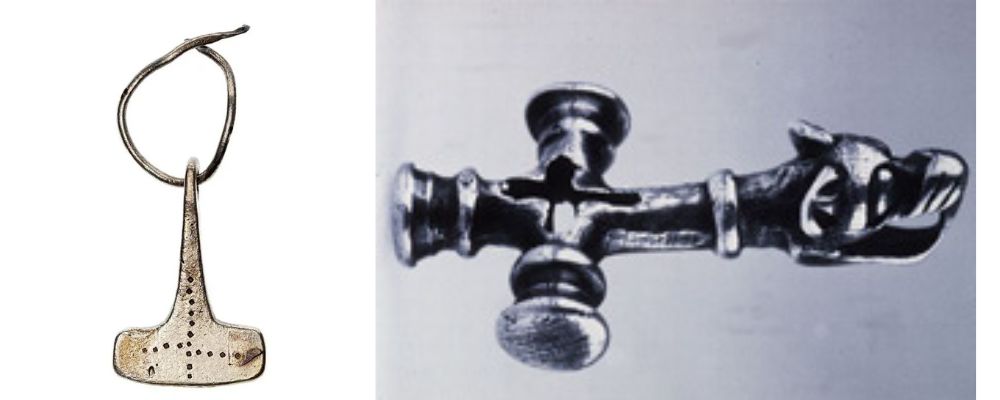
Swedish History Museum
This example stands out because the classic, plain Mjolnir pendant is etched with a Christian style cross made of dots. It may suggest that the pendant was adapted to incorporate the cross for a newly Christian Viking.
Foss, Iceland
This amulet is also known as the Wolf Cross since the handle is styled as a wolf’s head that bites the string from which it can be hung. The hammer shape is embedded with a cross, suggesting a mix of Christian and Nordic imagery. It is unclear whether this should be considered a Christian cross or a Thor’s hammer.
Find Your Mjolnir Pendant
If you are looking for a replica of an ancient Mjolnir pendant or one inspired by real Viking designs, you can find what you want in the VKNG store.
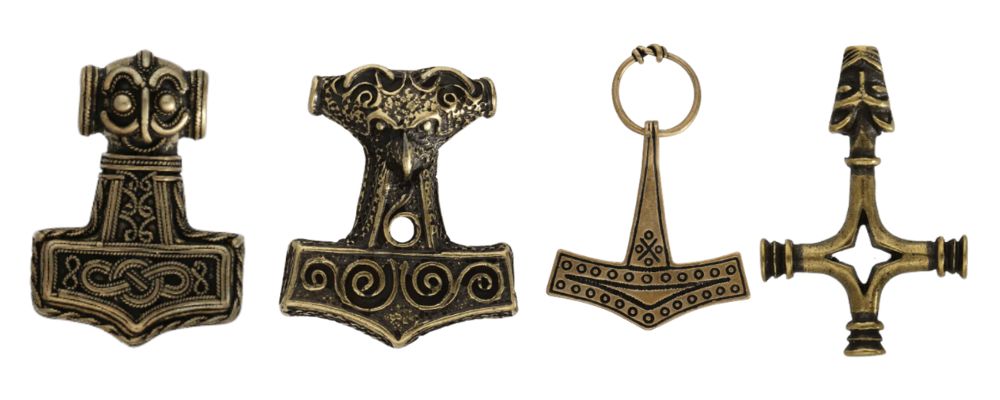
You can find replicas of the Odeshog, Scania, Romersdal, and Foss Mjolnir pendants in our collection, as well as more modern pieces that borrow the dot, knotwork, and raven-warrior design elements.
